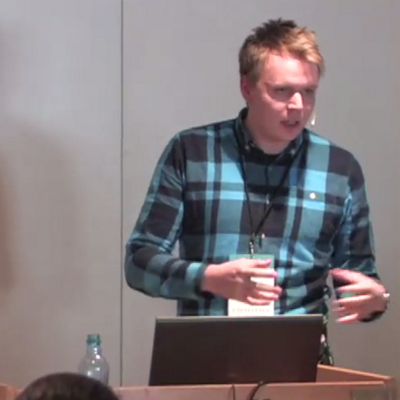JSConf Budapest is a JSConf family member 2-day non-profit for-the-community by-the-community conference about JavaScript in Budapest, Hungary.
Speakers

What’s does a mouse drag event have in common with an Array of numbers?
The answer to this question may surprise you: they are both collections.
This key insight holds the key to dramatically simplifying asynchronous programming in JavaScript. In this talk you will learn how you can use the familiar JavaScript Array methods to create surprisingly expressive asynchronous programs.
Using just a few functions, you will learn how to do the following:
- Declaratively build complex events out of simple events (ex. drag n’ drop)
- Coordinate and sequence multiple Ajax requests
- Reactively update UI’s in response to data changes
- Eliminate memory leaks caused by neglecting to unsubscribe from events
- Gracefully propagate and handle asynchronous exception
In this talk we’ll be exploring the Reactive Extensions (RxJS) library (http://github.com/reactive-extensions/RxJS), which allows us to treat events as collections. You’ll learn about how Netflix uses Rx on the client and the server, allowing us to build end-to-end reactive systems. We’ll also contrast Rx with Promises, another popular approach to building asynchronous programs in JavaScript.

Is 2015 the year of Virtual Reality? Experts suggest that VR will be a 5.2B industry within the next 2 years - but right now, the majority of VR development tools require heavy game engines and specialized desktops.
In this talk, we'll discuss the emerging support from the VR and web communities for WebVR, a new API emerging to support writing VR-enabled websites using HTML, CSS, and JavaScript. We'll be taking a look at existing applications for virtual reality on the web, the benefits of WebVR, and how to get started with the available tools and libraries for browser-based virtual reality written in JavaScript.

The battle between native and web rages on. The browsers are fighting hard to tear down the benefits that native
developers have relied on since the inception of mobile platforms. Geolocation, sorted. Accelerometer, done.
Performance, we'll come back to that. But one of the greatest draws for native developers has been push notifications,
for the web,
email alerts just don't cut it.
But now, new in browsers for 2015, is the Service Worker. Born out of the struggle to make the Appcache work for offline capable sites it has also brought the advent of push notifications to the web. Through building up an example application live we will see how to implement the Service Worker to not only serve up an app when we're offline but enhance the online experience with push notifications.
The battle may continue, but the web is definitely pushing back.

If extensive libraries and even the tiniest module followed SemVer strictly, dependency hell would be a thing of the past … but humans weren’t made to follow rules.
There are over 125.000 packages on npm today. By the time of this conference, at least another 10.000 will have been added. Using the right packages in your own modules and applications makes JavaScript the joy to develop it is today. But if even immensely popular libraries fail to properly declare breaking changes, how can we trust the over 50.000 strangers who developed all these modules? Currently we can’t. Let me show you how to write confidence-inspiring modules by leaving package publishing up to the machines – instead of buggy humans.

Web apps are great and everything, but imagine using JS to fly drones and make them dance to the sounds of dubstep! Or to control disco lights and other robots! Sounds fun, right? In this talk, we will not only explore how we can write code to make this possible, but it will also be full of exciting, interactive (and possibly dangerous ;) ) demos!

This talk will teach you a magic trick.
It will show you to stop our communities from breaking apart. Studies have shown that half the women who enter the technology field will over time leave. HALF! What’s happening? How did we get here? What can we do?
In my talk I will show you how we can fix the diversity problem, and why we should care. I'll tell you a true story about about role models, broken stereotypes - and cat gifs.
How to build community-driven initiatives that change our world. And the best part is: Everyone can do it. In one day.

The JavaScript world has seen stunning demos in 1024 bytes, crazy hacks in 140 characters and esoteric sequences of only 6 different symbols. This talk will push the limits even further and reveal, how to write "Invisible Code": Hidden programs that will execute with mind-bending magic.

Exploring MV*, user interfaces, unidirectional dataflow, reactive and functional programming

Get started coding real-time graphics in the browser with WebGL and three.js. Starting from the basic structure of a three.js web app, going through to the main elements of the API with several useful examples, will help you to get a foothold on the exciting world of 3D graphics, now on desktop and mobile. It's not required to have previous knowledge of 3D graphics, linear algebra or linear transforms.

Let us bring back the days where we could write declarative representations of how we want our UI components to work. We should be able to read our code from top to bottom and intuitively know what the output will be, just like the good old HTML, but with the power of functional programming.
In this talk we'll explore bringing functional programming into views. Instead of moving logic to markup through weird DSLs we bring expressive views into the programming language. We'll see how to create a UI where we have composable, pure and referentially transparent components; components with no side-effects and predictable output. We couple this with immutable data and components with single responsibilities, and we can get a fast and smart way to build UIs with a unidirectional flow and a simpler static mental model.

This talk is around enforcing coding standards in your JS project. We’ll discuss, as a use case, one of the libraries we use at Spotify in order to show the importance of keeping standards in your codebase.
In this session we’ll cover a few tools and practices you might want to follow when you build a JS library.

Wikis are a powerful data structure for collaboratively editing documents, but the data structures and social dynamics of wikis can be applied to other kinds of applications outside the narrow domain of encylopedic content.

Leave the routers and repeaters, the cabling and the splitters all behind. Just bring those phones, and let's go underground. Let's sit on a train and play music, left to our own devices, with our own devices.

Making sweeping changes across a codebase with confidence is difficult. How can you know what will go wrong? Etsy's Front End Infrastructure team recently converted their codebase from CSS to SCSS and is moving from inlined javascript to structured AMD modules. In this talk, Sufian will teach you the pitfalls, strategies, and tools you can use to ensure that large sweeping changes across your codebase will go smoothly.

Exploring the code and file structure of the internal C++ core bindings of io.js

Because dependency injection is cool and that it makes life of all us developers a looot easier, we start off this talk by first understanding what dependency injection stands for and why it is such a blessing in disguise...and also because first things first. Once that is clear we can dive deeper into some existing implementations, to get a real feel of how it all works, and finish by looking at how these implementations are used inside the new Angular 2, by embracing the power of TypeScript annotations.
News
Schedule!
We've put together the exact schedule for the two conference days!
Venue

Uránia Cinema in the middle of the city, near the party-district. Designed by Henrik Schmahl in the late 1890's, the interior is characterized by the ornamental motifs of the Venetian Gothic and Moor styles. The place is listed as the world's 3rd most beautiful cinema on Bored Panda, and many tech conferences were hosted here recently, like TEDx, and Strech Conference, because of the unique atmosphere.
Party

Recommended by The New York Times, Corvintető is a rooftop ruin bar and a modern, buzzing underground dance club above Blaha Lujza tér in Budapest, Hungary. We invite every attendee and speaker, as our guest, for a party above the city on the first day!
Sponsors
We're currently looking for sponsors, who help us make this conference experience awesome. Contact us if you're interested in sponsorship opportunities.













